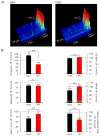Flecainide inhibits arrhythmogenic Ca2+ waves by open state block of ryanodine receptor Ca2+ release channels and reduction of Ca2+ spark mass
- PMID: 19835880
- PMCID: PMC2813417
- DOI: 10.1016/j.yjmcc.2009.10.005
Flecainide inhibits arrhythmogenic Ca2+ waves by open state block of ryanodine receptor Ca2+ release channels and reduction of Ca2+ spark mass
Abstract
Catecholaminergic polymorphic ventricular tachycardia (CPVT) is linked to mutations in the cardiac ryanodine receptor (RyR2) or calsequestrin. We recently found that the drug flecainide inhibits RyR2 channels and prevents CPVT in mice and humans. Here we compared the effects of flecainide and tetracaine, a known RyR2 inhibitor ineffective in CPVT myocytes, on arrhythmogenic Ca(2+) waves and elementary sarcoplasmic reticulum (SR) Ca(2+) release events, Ca(2+) sparks. In ventricular myocytes isolated from a CPVT mouse model, flecainide significantly reduced spark amplitude and spark width, resulting in a 40% reduction in spark mass. Surprisingly, flecainide significantly increased spark frequency. As a result, flecainide had no significant effect on spark-mediated SR Ca(2+) leak or SR Ca(2+) content. In contrast, tetracaine decreased spark frequency and spark-mediated SR Ca(2+) leak, resulting in a significantly increased SR Ca(2+) content. Measurements in permeabilized rat ventricular myocytes confirmed the different effects of flecainide and tetracaine on spark frequency and Ca(2+) waves. In lipid bilayers, flecainide inhibited RyR2 channels by open state block, whereas tetracaine primarily prolonged RyR2 closed times. The differential effects of flecainide and tetracaine on sparks and RyR2 gating can explain why flecainide, unlike tetracaine, does not change the balance of SR Ca(2+) fluxes. We suggest that the smaller spark mass contributes to flecainide's antiarrhythmic action by reducing the probability of saltatory wave propagation between adjacent Ca(2+) release units. Our results indicate that inhibition of the RyR2 open state provides a new therapeutic strategy to prevent diastolic Ca(2+) waves resulting in triggered arrhythmias, such as CPVT.
Copyright 2009 Elsevier Ltd. All rights reserved.
Conflict of interest statement
Disclosure Statement: The authors declare no conflict of interest
Figures






Comment in
-
An antidote for calcium leak: targeting molecular arrhythmia mechanisms.J Mol Cell Cardiol. 2010 Feb;48(2):279-82. doi: 10.1016/j.yjmcc.2009.11.005. Epub 2009 Nov 26. J Mol Cell Cardiol. 2010. PMID: 19931542 No abstract available.
Similar articles
-
Channel Activity of Cardiac Ryanodine Receptors (RyR2) Determines Potency and Efficacy of Flecainide and R-Propafenone against Arrhythmogenic Calcium Waves in Ventricular Cardiomyocytes.PLoS One. 2015 Jun 29;10(6):e0131179. doi: 10.1371/journal.pone.0131179. eCollection 2015. PLoS One. 2015. PMID: 26121139 Free PMC article.
-
RYR2 Channel Inhibition Is the Principal Mechanism of Flecainide Action in CPVT.Circ Res. 2021 Feb 5;128(3):321-331. doi: 10.1161/CIRCRESAHA.120.316819. Epub 2020 Dec 10. Circ Res. 2021. PMID: 33297863 Free PMC article.
-
Inhibition of cardiac Ca2+ release channels (RyR2) determines efficacy of class I antiarrhythmic drugs in catecholaminergic polymorphic ventricular tachycardia.Circ Arrhythm Electrophysiol. 2011 Apr;4(2):128-35. doi: 10.1161/CIRCEP.110.959916. Epub 2011 Jan 26. Circ Arrhythm Electrophysiol. 2011. PMID: 21270101 Free PMC article.
-
Moving in the right direction: elucidating the mechanisms of interaction between flecainide and the cardiac ryanodine receptor.Br J Pharmacol. 2022 Jun;179(11):2558-2563. doi: 10.1111/bph.15718. Epub 2021 Dec 2. Br J Pharmacol. 2022. PMID: 34698387 Review.
-
Inhibitors of Intracellular RyR2 Calcium Release Channels as Therapeutic Agents in Arrhythmogenic Heart Diseases.Annu Rev Pharmacol Toxicol. 2025 Jan;65(1):443-463. doi: 10.1146/annurev-pharmtox-061724-080739. Epub 2024 Dec 17. Annu Rev Pharmacol Toxicol. 2025. PMID: 39374431 Review.
Cited by
-
Calcium Sparks in the Heart: Dynamics and Regulation.Res Rep Biol. 2015;6:203-214. doi: 10.2147/RRB.S61495. Epub 2015 Oct 16. Res Rep Biol. 2015. PMID: 27212876 Free PMC article.
-
Pharmacology of myocardial calcium-handling.Wien Med Wochenschr. 2012 Jul;162(13-14):311-5. doi: 10.1007/s10354-012-0108-x. Epub 2012 Jun 16. Wien Med Wochenschr. 2012. PMID: 22707076 Review.
-
The ryanodine receptor store-sensing gate controls Ca2+ waves and Ca2+-triggered arrhythmias.Nat Med. 2014 Feb;20(2):184-92. doi: 10.1038/nm.3440. Epub 2014 Jan 19. Nat Med. 2014. PMID: 24441828 Free PMC article.
-
Calcium Handling Defects and Cardiac Arrhythmia Syndromes.Front Pharmacol. 2020 Feb 25;11:72. doi: 10.3389/fphar.2020.00072. eCollection 2020. Front Pharmacol. 2020. PMID: 32161540 Free PMC article. Review.
-
Calcium Signaling and Cardiac Arrhythmias.Circ Res. 2017 Jun 9;120(12):1969-1993. doi: 10.1161/CIRCRESAHA.117.310083. Circ Res. 2017. PMID: 28596175 Free PMC article. Review.
References
-
- Nabauer M, Callewaert G, Cleemann L, Morad M. Regulation of calcium release is gated by calcium current, not gating charge, in cardiac myocytes. Science. 1989 May 19;244(4906):800–3. - PubMed
-
- Bers DM. Calcium fluxes involved in control of cardiac myocyte contraction. Circ Res. 2000 Aug 18;87(4):275–81. - PubMed
Publication types
MeSH terms
Substances
Grants and funding
LinkOut - more resources
Full Text Sources
Other Literature Sources
Medical
Research Materials
Miscellaneous

